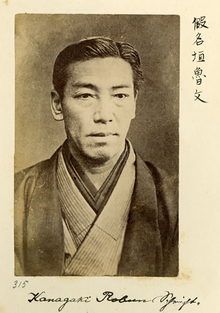| Kanagaki Robun | |
|---|---|
| 仮名垣 魯文 | |
 | |
| Born | (1829-02-09)9 February 1829 Edo, Musashi Province, Japan |
| Died | 8 November 1894(1894-11-08) (aged 65) Tokyo, Tokyo Prefecture, Japan |
| Nationality | Japanese |
| Other names | Nozaki Bunzō (野崎 文蔵) |
| Alma mater | Hanagasa Bunkyō (master) |
| Occupation(s) | Journalist, writer, novelist |
| Employer(s) | Worked for Kanagawa Prefectural Government, Yokohama Mainichi Shimbun |
Kanagaki Robun (仮名垣 魯文) was the pen name of Nozaki Bunzō (野崎 文蔵) (9 February 1829 – 8 November 1894), a Japanese author and journalist.
Career
Kanagaki Robun, the son of a fishmonger, was originally known for light fiction in the gesaku genre. He is said to have met painter Kawanabe Kyosai while writing an account of the 1855 Edo earthquake on the day after it happened. Kyosai's sketch of a catfish, accompanying Robun's text, was Kyosai's first single-sheet ukiyo-e woodblock print. Its commercial success saw Robun producing a sequence of catfish pictures (known as namazu-e). In 1874 the pair collaborated to create what was effectively Japan's first manga magazine, Eshinbun nipponchi (Illustrated News).
In 1874 Robun turned to journalism, joining the Yokohama mainichi shinbun and going on in 1875 to found his own newspaper, the Kana-yomi shinbun (Kana Newspaper). His newspaper pioneered the genre of "dokufu-mono," criminal biographies of female outlaws, and Kanagaki Robun's own Tale of Takahashi Oden the She-Devil (written rapidly after Takahashi Oden was beheaded for killing a man) is the most famous example of the genre.
He also wrote illustrated biographies, including an adapted biography of Ulysses S. Grant published for Grant's 1879 visit to Japan.
Works
- Collected Rumors of Ansei (安政風聞集, Ansei fūbunshū) (1856)
- Account of the Ansei Cholera Epidemic (安政頃痢流行記, Ansei korori ryūkōki) (1856)
- Journey on Foot to the Western Sea (西洋道中膝栗毛, Seiyōdōchū hizakurige) (1870–76), a parody of Jippensha Ikku's Tōkaidōchū Hizakurige
- The Beefeater (安愚楽鍋, Aguranabe) (1871)
- The Cucumber Messenger (胡瓜遣, Kyurisukai) (1872)
- Connoisseur of Western-Style Cuisine (西洋料理通, Seiyō ryōritsu) (1872)
- Chronicle of the Saga Telegraph Line (佐賀電信録, Saga denshinroku) (1874)
- The Tale of Takahashi Oden, the She-Devil (高橋阿伝夜叉譚, Takahashi Oden yasha tan) (1879)
- A Japanese Print of Hamlet (葉武列土倭錦絵, Hamuretto Yamato nishikie) (1886)
References
- ^ Peter Duus (2013). "'Punch Pictures': Localising Punch in Edo Japan". In Hans Harder; Barbara Mittler (eds.). Asian Punches: A Transcultural Affair. Springer Science & Business Media. p. 319. ISBN 978-3-642-28607-0.
- Hiroshi Nara (2007). Inexorable Modernity: Japan's Grappling with Modernity in the Arts. Lexington Books. p. 22. ISBN 978-0-7391-5637-7.
- Mark Silver (2008). Purloined Letters: Cultural Borrowing and Japanese Crime Literature, 1868-1937. University of Hawaii Press. pp. 30–32. ISBN 978-0-8248-3188-2.
- Scott J. Miller (2009). Historical Dictionary of Modern Japanese Literature and Theater. Scarecrow Press. p. 46. ISBN 978-0-8108-6319-4.